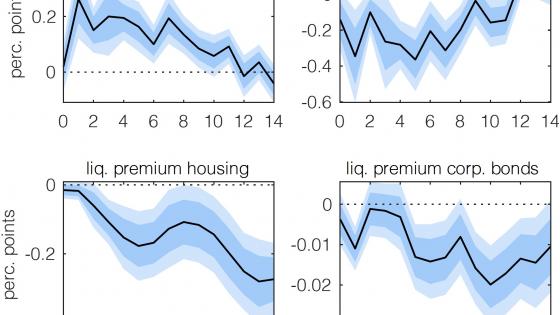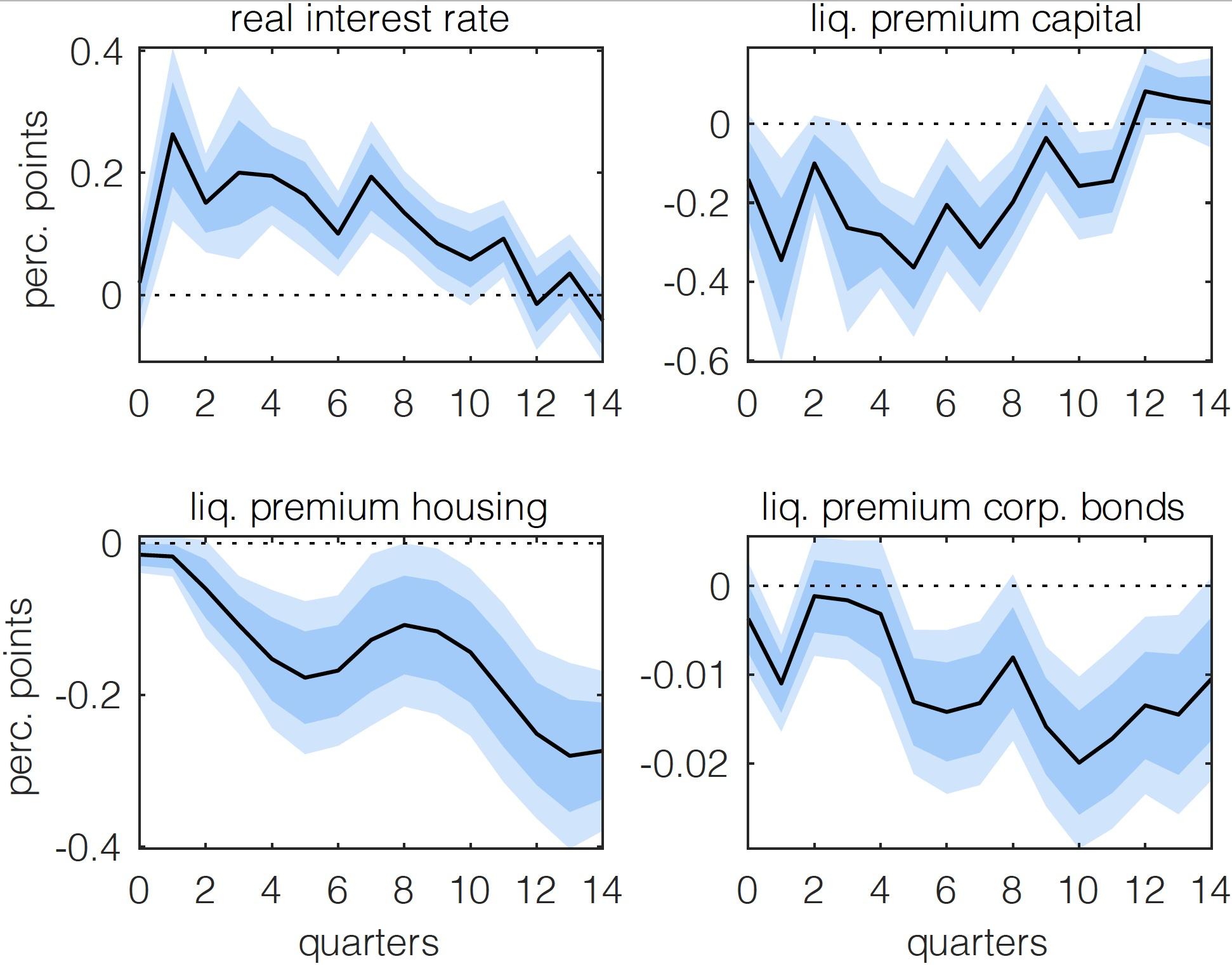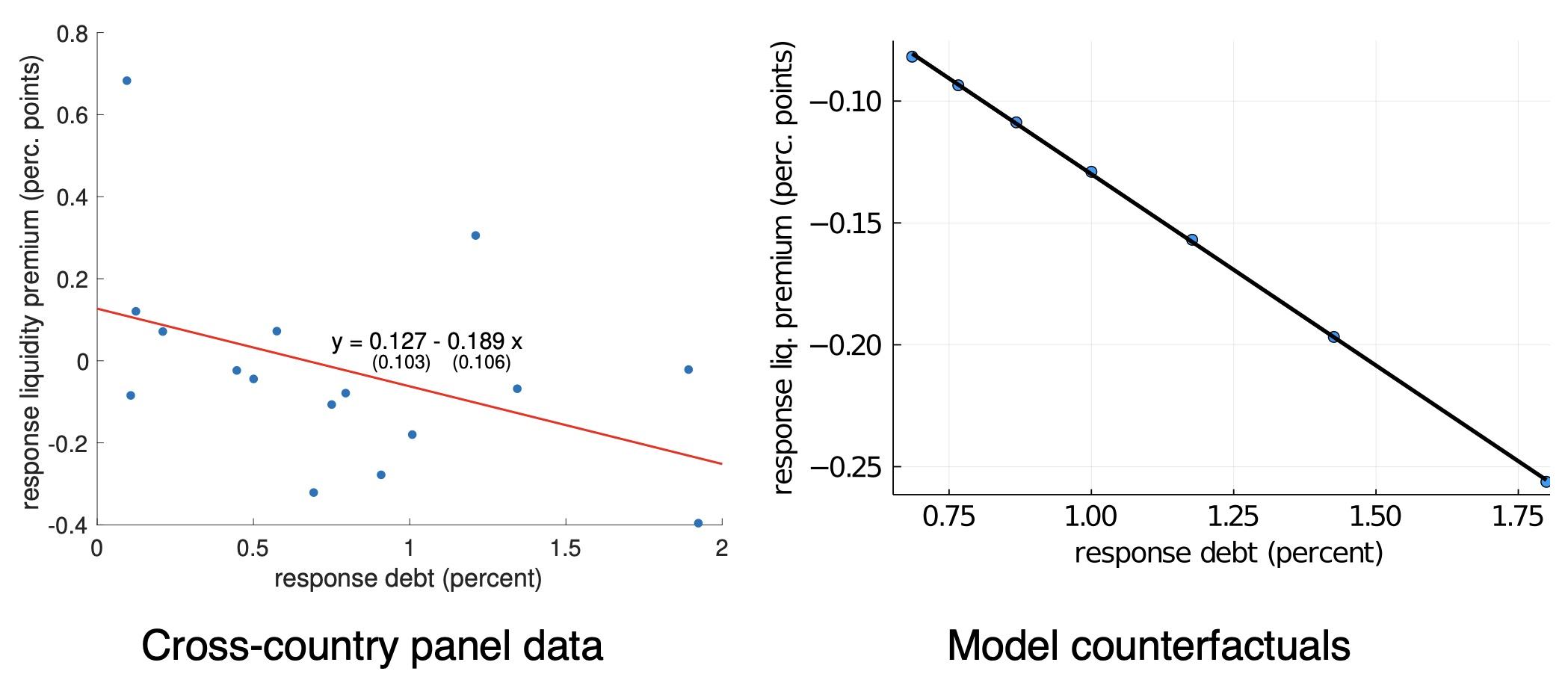In response to the 2020 recession, governments around the world have issued substantial public debt to finance large-scale transfers and government spending (IMF 2021). With public debt climbing to levels unprecedented in peacetime, it has become a pressing issue to understand the effects that this has on the economy and in particular on government bond yields – both in the short run and in the long run. The academic debate regarding the effect and optimal size of public debt has, at least since the seminal work by Aiyagari and McGrattan (1998), focused on public debt crowding out capital. In a recent paper (Bayer et al. 2021), we argue that it is key to consider the stronger role of public debt as private liquidity compared to capital (Woodford 1990) in answering these questions. We find little impact of higher public debt on the private capital stock in the short and long run. But as a fiscal expansion increases the interest rate on existing public debt, it has a strong impact on the government's budget.
The short run
We are interested in understanding the effects of an expansion of public debt on interest rates, in particular the return differences between public debt and less liquid assets. A difficulty with this question is that most changes in public debt are endogenous responses to other shocks. We therefore look at exogenous changes in government spending or taxes – for which identification approaches are established within the existing body of research – that increase public debt in their aftermath.
Our time-series estimates are based on local projections (in the style of Jordà 2005), estimated on quarterly US data from 1947Q1 to 2015Q4. Figure 1 shows that the real long-term government bond rate increases by 25 basis points after the exogenous fiscal expansion, normalised such that government debt increases by 1%.1 The increase in the bond rate goes along with a significant fall in all variants of the liquidity premium. The premia on capital (Gomme et al. 2011) and housing (Jordà et al. 2019) fall by around 20-35 basis points. The liquidity premium on corporate bonds, or convenience yield (Krishnamurthy and Vissing-Jorgensen 2012), falls by two basis points, which is the most conservative measure of the liquidity premium because it looks at the spread between very similar financial assets – government and corporate bonds – that are highly marketable.
Figure 1 Local projection evidence for the US
Using the Jordà-Schularick-Taylor ‘macrohistory database’, we can exploit heterogeneity across countries relating the response of the liquidity premium to the amount of debt issued to finance the fiscal expansion. In those countries in which public debt increases more, the liquidity premium also declines significantly more.2 The size of the effect is within 19 basis points for a 1% increase in debt, consistent with the estimate for the US (see the left panel of Figure 2).
Next, we adapt the heterogeneous-agent New-Keynesian model of Bayer et al. (2020) and estimate it using Bayesian methods. This model is well-suited to study fiscal policy because it features all shocks and frictions of the seminal Smets and Wouters (2007) model, as well as self-insurance, the private creation of liquid assets through unsecured credit, and portfolio choice between assets of different liquidity. Therefore, fiscal policy operates through more than the traditional Keynesian channels because it affects the liquidity premium too.
Figure 2 International panel data vs model
The model replicates the findings from the local projections and provides a laboratory to study the importance of this liquidity channel of fiscal policy (see the right panel of Figure 2). In the short run, this movement in the liquidity premium increases the economy's response to the fiscal stimulus. Fiscal multipliers are, on impact, 40% larger in the economy with an endogenous liquidity premium relative to the same economy with a constant one. There are two forces behind this result. First, the increase in liquidity improves the self-insurance of households overall, boosting consumption. Second, as liquid and illiquid assets are imperfect substitutes, an increase in public debt does not substitute one-for-one physical assets as savings devices.
The long run
Importantly for the current debate, the model also allows us to study more persistent changes in public debt. In particular, we ask how an increase in public debt affects interest rates in the long run and, in addition, what effects such a policy has on the capital stock and inequality. Specifically, we consider a quasi-permanent increase in the debt target by 10%.
We model the adjustment period stretched over ten years and focus on the increase in debt being paid out as non-distortionary transfers. We find that this fiscal policy increases the nominal rate (permanently) by 62 basis points (annualised), and inflation by 37 basis points. Our estimated model implies a semi-elasticity of the real bond rate with respect to public debt of 0.025.3 In other words, interest rates typically overshoot in the short run. The long-run elasticity of real bond rates to the size of public debt is an order of magnitude smaller than what the short-run response suggests. The return on the illiquid asset, by contrast, moves very little. This affects the relative incentives to save for the rich (who mostly save illiquid) and the poor (who mostly save liquid) asymmetrically. As a result, the increase in debt persistently lowers wealth inequality.
The fact that public debt and fixed capital are imperfect substitutes from the household's point of view is behind both the pronounced interest-rate response and the limited crowding out of capital. If all assets are equally liquid (and hence perfect substitutes), as in the standard incomplete markets setup (Aiyagari and McGrattan 1998), there is more crowding out and a smaller movement in the interest rate. If there are complete markets on top, then Ricardian equivalence holds.
With illiquid capital, the government can increase the capital stock substantially if it uses the receipts from issuing public debt to foster fixed-capital investment. We model this as a sovereign wealth fund. Such an extension of the government's balance sheet drives down the liquidity premium and increases output and capital in the long run. As wages increase and the return on capital falls, the economy becomes more equal. But we estimate the necessary increase in bond yields on outstanding public debt to dominate what the government can earn as a return on the additional capital. As a result, taxes need to increase slightly in the long run to finance the sovereign wealth fund.
Figure 3 The fiscal implications of public debt
This statement depends crucially on the initial amount of outstanding public debt because bond rates depend on the latter – implying a Laffer-curve relationship. The government can earn a form of ‘liquidity tax’ – the difference between the bond rate and the growth rate of the economy – if bonds are scarce (e.g. Bassetto and Cui 2018, Blanchard 2019, Wyplosz 2019, Reis 2021).
The left-hand panel of figure 3 shows the fiscal burden of public debt, R(B)B/Y. The right-hand panel shows the interest-growth differential, R(B). Both are plotted against the level of public debt, B/Y. All values are relative to annual output in the steady state. The black line corresponds to our baseline, which is calibrated to average US public debt and interest rates over the last 70 years. There are two intercepts of the fiscal burden of debt with zero, at B/Y = 0 and at B/Y = 59%. The second point corresponds to our steady state that features a zero interest-growth differential. A higher debt-to-GDP ratio increases the interest rate burden, while a lower ratio decreases the burden at first. As interest rates become negative, the government generates revenues from rolling over debt. But as debt vanishes, so do these revenues from rolling over.
Using our approximation for the US, we find that the public debt level that minimises the fiscal burden of debt is around 60% of GDP for the last decade (see Figure 3). Any target level below this number provides less liquidity to the private sector and less revenues to the government at the same time. Historically, however, this critical debt level has been much smaller, at 20% of GDP. Our model predicts that today a debt-to-GDP ratio of 160% would achieve a zero interest-rate-growth differential.
Conclusion
We provide new evidence for the response of interest rates to public debt. We find that the return differences between public debt and less liquid assets significantly falls in fiscal expansions. A 1% increase in public debt leads to a 25 basis points increase in the real rate on public debt in the short run, and a 2.5 basis points increase in the long run relative to the return on less liquid assets.
The substantial elasticity of the real interest rate to persistent public debt movements has important fiscal implications. We provide a simple formula to approximate the marginal fiscal burden of debt and to calculate both a revenue-maximising level of public debt and the level of debt that equates the rates of interest and growth.
We exemplify the fiscal cost of public debt in excess of the current interest rate by looking at an increase in public debt that either finances a transfer programme or finances a sovereign wealth fund in an estimated HANK model. Even though the returns that this fund makes on its investment in capital are higher than its financing cost, the government's budget in total worsens as a result of the introduction of such a fund. The fiscal cost is lower in the second scenario because the capital stock increases. What is more, an increase in government debt by compressing the liquidity premium lowers wealth inequality.
References
Alcidi, C and D Gros (2019), “Public debt and the risk premium: A dangerous doom loop”, VoxEU.org, 23 May.
Aiyagari, S R and E R McGrattan (1998), “The optimum quantity of debt”, Journal of Monetary Economics 42(3): 447-469.
Bassetto, M and W Cui (2018), “The fiscal theory of the price level in a world of low interest rates”, Journal of Economic Dynamics and Control 89: 5–22.
Bayer, C, B Born and R Luetticke (2020), “Shocks, Frictions, and Inequality in US Business Cycles”, CEPR Discussion Paper 14364.
Bayer, C, B Born and R Luetticke (2021), “The Liquidity Channel of Fiscal Policy”, CEPR Discussion Paper 14883.
Blanchard, O (2019), “Public debt and low interest rates”, American Economic Review 109(4): 1197-1229.
Blanchard, O and R Perotti (2002), “An empirical characterization of the dynamic effects of changes in government spending and taxes on output", The Quarterly Journal of Economics 117(4): 1329-1368.
Gomme, P, B Ravikumar and P Rupert (2011), “The return to capital and the business cycle”, Review of Economic Dynamics 14(2): 262–278.
International Monetary Fund (2021), Fiscal Monitor, April.
Jordà, Ò (2005), “Estimation and inference of impulse responses by local projections”, American Economic Review 95(1): 161-182.
Jordà, Ò, K Knoll, D Kuvshinov, M Schularick and A M Taylor (2019), “The rate of return on everything, 1870–2015”, The Quarterly Journal of Economics 134(3): 1225-1298.
Krishnamurthy, A and A Vissing-Jorgensen (2012), “The aggregate demand for treasury debt”, Journal of Political Economy 120(2): 233-267.
Reis, R (2021), “The constraint on public debt when r< g but g< m”, CEPR Discussion Paper 15950.
Smets, F and R Wouters (2007), “Shocks and frictions in US business cycles: A Bayesian DSGE approach”, American Economic Review 97(3): 586-606.
Summers, L H and L Rachel (2019), “On falling neutral real rates, fiscal policy and the risk of secular stagnation”, in Brookings Papers on Economic Activity BPEA Conference Drafts, March.
Presbitero, F and U Wiriadinata (2020), “The risks of high public debt despite a low interest rate environment”, VoxEU.org, 5 August
Woodford, M (1990), “Public debt as private liquidity”, The American Economic Review 80(2): 382-388.
Wyplosz, C (2019), “Olivier in Wonderland”, VoxEU.org, 17 June.
Endnotes
1 We use the long-term government bond rate from Krishnamurthy & Vissing-Jorgensen (2012) with maturity of 10 years or more.
2 In our analysis we abstract from open-economy and sovereign-default considerations. See Alcidi and Gros (2019) or Presbitero and Wiriadinata (2020), for a discussion of fiscal policy in these contexts.
3 This is in line with the summary of estimates in the literature in Summers & Rachel (2019), Table 2.









